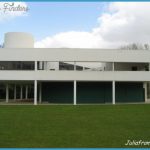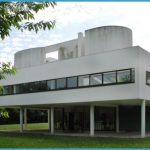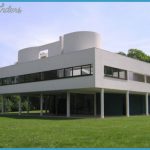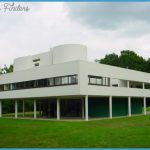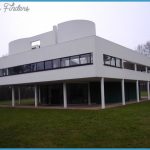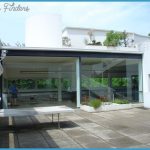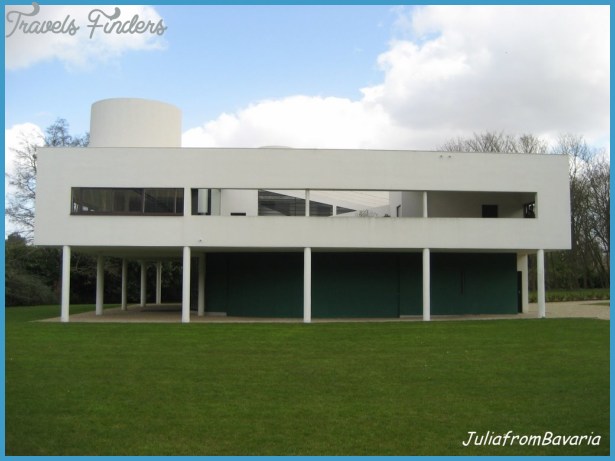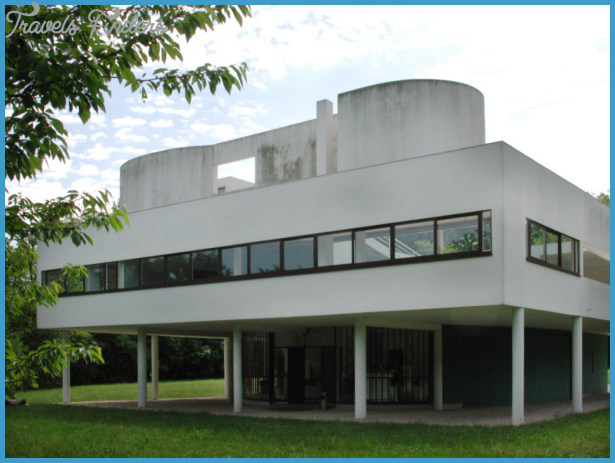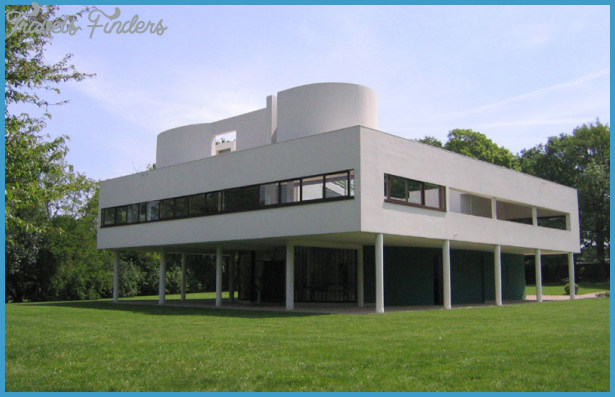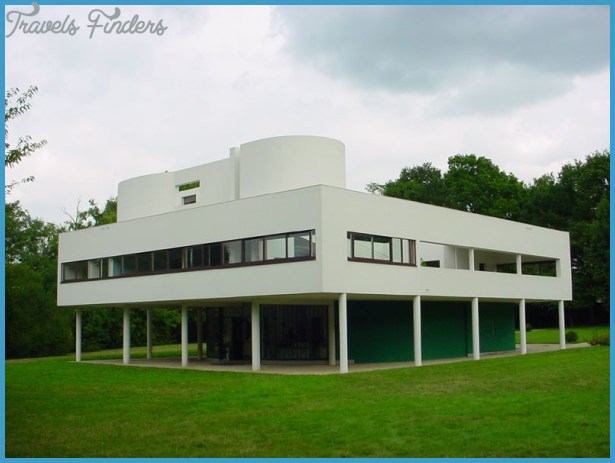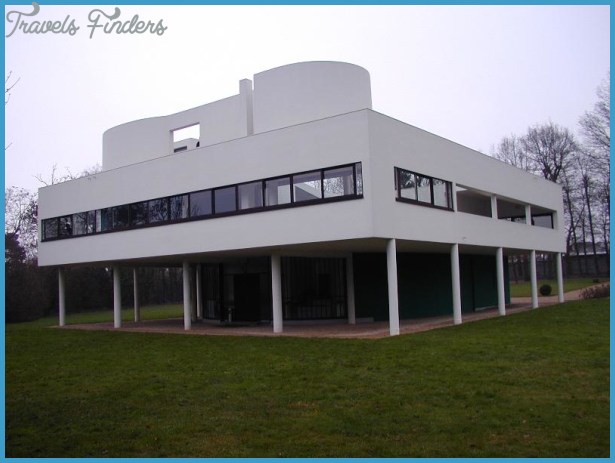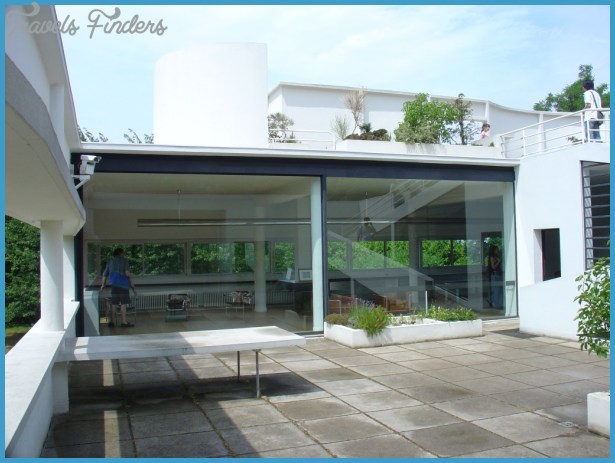LE CORBUSIER
With its white walls, generous windows, and open-plan living areas, the Villa Savoye is perhaps the most iconic house by the great architect, Le Corbusier. When he was commissioned to design this country retreat on the outskirts of Paris, Le Corbusier was already a pioneer of modernist architecture-an innovative style based upon the idea that the form of a building was determined by its function. In modernist buildings materials such as concrete and glass were used in striking new ways.
In his book of 1932, Vers Une Architecture (Toward An Architecture), Le Corbusier listed five principles that modern buildings should follow: they should use pilotis (narrow columns) to raise the building above the ground; have a “free fagade, in which design was not dictated by structure; an open floorplan; strip windows to make the interior light; and a roof garden to compensate for the lack of ground space. At the Villa Savoye, the slender, white pilotis support the weight of the building, leaving open space beneath it. Freed from structural constraints, the fagades of the Villa Savoye have clean, uncluttered lines. The living accomodation is on the first floor above the pilotis, while the central block on the ground floor contains the entrance to the villa and the service rooms.
Le Corbusier was able to dispense with load-bearing walls inside the building too, and created a series of airy spaces that flow smoothly into each other. The long strip windows not only flood the house with natural light, but also provide it with views in all directions, and the roof garden replaces the green area on which the house stands. The ramps, screen walls, and extensive windows of this elegant house make it seem as if the interior and the roof garden merge seamlessly, creating an elegant, minimalist structure with beautiful, light-filled internal spaces. Widely admired, the Villa Savoye is considered one of the finest examples of modernist architecture.
1887-1965
Charles-Edouard Jeanneret, who practiced architecture under the name of Le Corbusier, was born in La Chaux-aux-Fonds, Switzerland, where he attended the local art school. He also studied in Vienna, and as a young man worked for two great architects French concrete pioneer Auguste Perret and German modernist Peter Behrens. After World War I Le Corbuisier set up in practice with his cousin, Pierre Jeanneret, and became famous for designing immaculate modernist houses that combined functionalism with a unique elegance. A house is a machine for living in, he wrote. In the 1930s Le Corbusier worked on ideas for city planning, publishing La Ville Radieuse (The Radiant City) in 1935, and after World War II he built a number of large urban blocks called Unites d’Habitation (Living Units), which contained apartments, shops, and other facilities. During the same time he also worked on plans for the city of Chandigarh, India, and designed smaller-scale, sculptural buildings in concrete, such as the pilgrimage chapel at Ronchamp in France. Le Corbusier’s innovative buildings and numerous writings have made him one of the most influential of all 20th-century architects.
Visual tour
2 PILOTIS The owner’s accommodation on the first floor and the terrace above it are raised up on plain, unadorned pilotis. This frees up the ground floor for a central block containing the entrance hall, stairs, and ramp, rooms for the chauffeur and maid, and the garage. The paved area beneath the main house was exactly the right width for the owner’s car a 1927 Citroen admired by Le Corbusier to drive around.
3 FACADE Large strip windows run all around the fagade, providing fine, uninterrupted views in all directions from the main rooms of the house. The walls above the windows appear to have no visible means of support. Le Corbusier was only able to build in this way because most of the building’s weight is borne by the pilotis. As the walls were lightweight, rather than load-bearing, he had more freedom to concentrate on their appearance.
3 LIVING AREA The main living room is uncluttered, and the walls, floors, and ceilings are all white, or pale in color. This interior connects seamlessly with part of the roof garden by means of a full-height glass wall and a sliding screen of glass. This layout is a perfect example of Le Corbusier’s idea of the open floor plan. Because the walls do not have to support the weight of the house, they can be made of a non-load-bearing material such as glass and can be positioned wherever they are needed from an aesthetic point of view.
4 RAMP TO ROOF The main levels of the house are linked by stairs, but they can also be accessed by gently sloping ramps, such as this one that leads up toward the roof garden and sun terrace at the top of the building. The ramps cut through the house and open up interesting views. Le Corbusier wanted the ascent to end with one of the most important spaces in the house the roof garden, where people could enjoy the warmth and beneficial effects of the sun.
The evenly spaced pilotis support the weight of the house
4 STAIRS The internal stairs set up a rhythm of curves that counterpoint the straight lines and rectangles that define most of the interior. The white curves are thrown into relief by black rails and uprights, reflecting a theme that runs throughout the villa, in which dark doors and window frames form a contrast to the white walls. This interplay of curves and straight lines, and black and white, gives the interior a sculptural quality that is emphasized by the natural light from the windows, which changes throughout the day.
Central block
ON CONSTRUCTION
Le Corbusier was fascinated by the structural possibilities of reinforced concrete. From 1914 to 1915 he worked with the French architect Auguste Perret, a pioneer of modern concrete construction, on a design for a house he called the Dom-ino (a name in which domus, the Latin word for house, is merged with dominos, the game). The floors of the Dom-ino were to be made of concrete slabs and to have supporting concrete posts, thereby eliminating the need for horizontal beams. Setting the posts slightly inside the edges of the floor slabs made it possible to fit lightweight, non-load-bearing walls around them. Le Corbusier hoped that the Dom-ino would provide a cheap form of mass housing after World War I. The project was never realized, but it gave Le Corbuisier an insight into how to build houses such as the Villa Savoye.
1 Barcelona Pavilion
Mies van der Rohe’s German Pavilion for the Barcelona International Exposition of 1929 is an elegant composition of stone slabs and walls of glass.
IN CONTEXT
Le Corbusier is known as one of the leaders of European modernism. This style of architecture developed in the early decades of the 20th century and can also be seen in the work of German architects such as Ludwig Mies van der Rohe and Walter Gropius.
The modernists embraced the idea that form follows function and used industrial materials such as steel, glass, and concrete. They displayed structural elements that had previously been considered ugly and minimized applied ornament. They liked light, uncluttered interiors and preferred flat roofs to traditional pitched ones. Although these features sometimes made the buildings seem stark, good modernist architecture has a beauty of form and fitness for purpose that have ensured the style is still influential today.
1 BATHROOM Next to the master bedroom is this bathroom.
A curtain may be pulled across the end of it for privacy, or left open, as above. The bathroom has a blue-tiled bath with a built-in, raised, reclining seat running across one end rather like a wall. This unusual design was perhaps influenced by the Turkish baths that Le Corbusier had visited as a young man, when he traveled around the Mediterranean looking at local styles of architecture.
1 Design for the Dom-ino house
The frame of the house consisted of flat slabs of concrete and pilotis, like those of the Villa Savoye.

